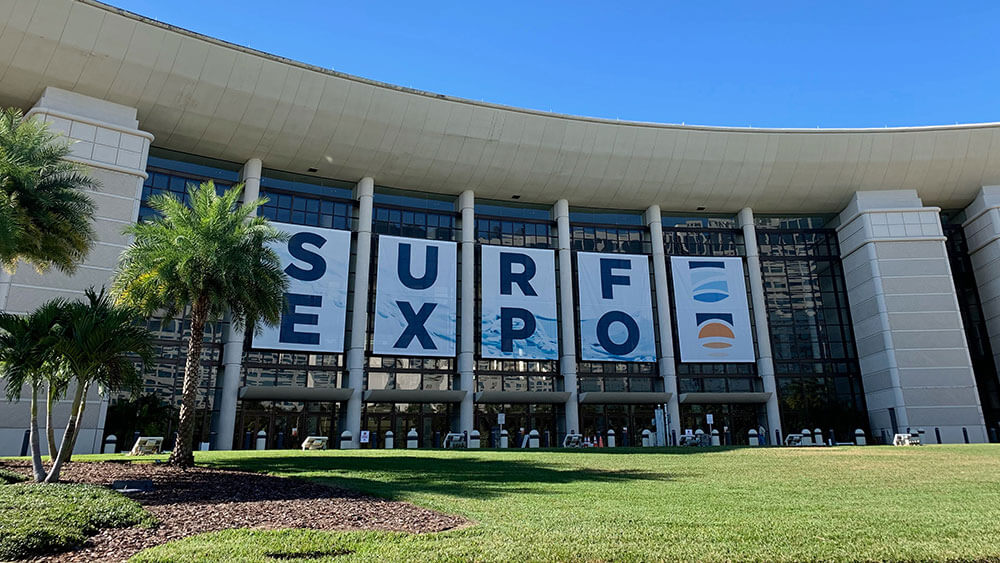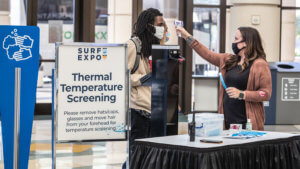
SISO (Society of Independent Show Organizers) and UFI, the Global Association of the Exhibition Industry, released a case study to share the challenges faced by Emerald in producing Surf Expo in early January in Orlando. (Photos courtesy of Surf Expo)
When Surf Expo — the first major B2B trade show in the U.S. in 2021 — opened at Orlando’s Orange County Convention Center (OCCC) in early January, it was more of a deep dive than a dip into in-person events during the pandemic. The show floor was 100,000 net square feet.
While that scale represented less than half of pre-COVID levels, Surf Expo’s show producer, Emerald, said it clearly demonstrated a market need in this sector. A recent case study produced by SISO (Society of Independent Show Organizers) and UFI, the Global Association of the Exhibition Industry, “Riding the Wave: Surf Expo Shifts to Serve Market Needs,” outlined the challenges faced by Emerald in producing the event as well as how the event was received by attendees and exhibitors. Here are highlights of the SISO-UFI case study.

Surf Expo producers absorbed some health and safety costs, including temperature checks at the Orange County Convention Center in Orlando.
Hosting the event at the GBAC STAR-accredited OCCC ensured a clean, safe, and healthy environment, and Visit Orlando and OCCC worked with Surf Expo to produce a video (see below) so that participants would know what to expect at Surf Expo.
But there were still health and safety costs absorbed by the show producer, including hand sanitizer, masks, temperature checks, security, monitors, signage, extra cleaning, and staffing. Using IGES, a gift show Emerald produced in November in Tennessee, as an example, Emerald CFO David Doft said that the company spent about $20 per attendee on those health and safety initiatives.
“As we’ve been budgeting larger events, there are definitely scale efficiencies,” Doft said. “The larger the show, the lower the per-person cost. But if you multiply that out across all our events, you’re talking millions.”
Emerald chose to absorb those additional costs and not pass them on to exhibitors, chalking them up to what it takes to do business in the new normal.
Hard Times
The No. 1 challenge Surf Expo faced was that 95 percent of its surf business is based in Southern California. A lot of those businesses have been shut down since last March. Added to that were a range of travel bans and restrictions, which meant that some of Surf Expo’s largest brands could not participate in the event. Surf Expo was, however, able to attract some first-time exhibitors that were within driving distance of Orlando.
New Dynamics
The second challenge was adapting to current market needs. Roy Turner, Surf Expo show director, modified this year’s show floor plan, creating product groupings to better reflect the different mix of exhibitors this year. There were also customers who canceled up until the very last moment — but other customers who were buying until the last possible moment. “We were selling booths up until two days before the show,” Emerald COO Brian Field said.
Striking a Balance
A third challenge was being fully transparent with customers. “You’re excited about the show, but you’re still trying to present reality” to customers, Turner said. “We’re telling the buyers and brands that before you get on a plane, I want you to make absolutely sure you know who’s coming in. We want to make a trip worthwhile for them.”
One exhibitor, Los Angeles–based apparel company Psycho Tuna, found attending the show worth it, even though its vice president, Patricia Thornton, had to quarantine for 10 days upon return to California. “I had zero expectations coming to the show,” Thornton said, but the first day on the floor was “insanely busy,” and she got new and repeat business. “Retailers are telling me,” she said, “they are excited to touch and feel the merchandise.”
With the COVID-19 crisis still fluid, there were a number of cancellations. Ninety percent of the exhibitors that chose to cancel didn’t ask for refunds. “They simply transferred their money to our September event,” Turner said. (Surf Expo will be held again at the OCCC, Sept. 9-11.)

The vice president of Los Angeles–based apparel company Psycho Tuna said exhibiting at Surf Expo was worth the effort because the company gained new and repeat business.
Marketing an in-Person Event During COVID
The final major challenge Emerald faced was marketing during COVID-19. Turner said that half of its audience wanted the event in person and half didn’t. The marketing messages focused heavily on health and safety measures. For example, Emerald announced in November that Surf Expo would be moving from the North/South Concourse to the West Concourse to gain extra space to ensure social distancing.
In addition, Emerald shifted from promoting specific brands and categories to “promoting the floor plan and the most up-to-date exhibitor list, due to last-minute changes based on corporate travel bans, local restrictions, and overall health concerns,” said Adrienne Belk, Emerald’s vice president of marketing. “Expect and plan for pivots,” she advised. Her team kept a close eye on social chatter and email replies to tailor its messaging. “Develop approved talking points early to ensure the internal team is prepared in advance,” Belk said, “to respond consistently to tough questions.”
How successful was the event? Perhaps the better question asked in the case study is What makes the show a success? “Buyers and sellers interacting with one another,” Field said. “Ultimately, when people ask why we’re running the show, the answer is simple: Surf Expo’s customers told us they want us to do business. And for many, our show is a critical marketplace for their survival. It’s our responsibility to provide our customers with that opportunity, even though everyone understands that the show experience will be different.”
Michelle Russell is editor in chief of Convene.
